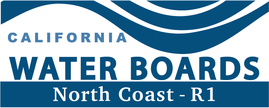Salmon River TMDL
The Salmon River Watershed is listed on the Section 303(d) List for impairment or threat of impairment to water quality associated with nutrients and temperature. The North Coast Regional Board is the lead agency for development of the Salmon River TMDLs. North Coast Regional Board staff performed fieldwork in the watershed in 2002. No evidence of impairment from elevated levels of nutrients was observed. As part of the 2004 update of the Section 303(d) List, Regional Board staff recommended to the State Water Resources Control Board that the Salmon River be delisted for nutrients. Regional Board staff completed the analysis and report documenting findings associated with temperature conditions and sources of temperature impairment in the Salmon River watershed. This was prepared as the Salmon River Temperature Total Maximum Daily Load and Implementation Plan. This TMDL and Implementation Plan document, as adopted on June 22, 2005 through Regional Water Board Resolution No. R1-2005-0058, is available below.
(note: File sizes vary. It is advisable to download the pdf documents to your local drive in order to view/print etc.)
- Resolution No. R1-2005-0058 - Adopting the Salmon River Total Maximum Daily Load for Temperature and Implementation Plan (19 Kbytes)
Total Maximum Daily Load for Temperature and Implementation Plan
- Part 1 - Text
- Part 2 - Figures (7.5 Mbytes)
- Part 3 - Appendix A: Anadromous Salmonids in the Salmon River, California: A Summary From the Literature. (2.7 Mbytes)
- Part 4 - Appendix B: Temperature Analysis (1 Mbyte)
- Part 5 - Appendix C: Control Measures to Improve Riparian Conditions (257 Kbytes)
- Part 6 - Appendix D: Temperature Data Information (428 Kbytes)
- Part 7 - Appendix E: Comments (286 Kbytes)
- Part 8 - Appendix F: Response to Comments (24 Kbytes)
Salmon River Memorandum of Understanding
The Salmon River TMDL for Temperature and Implementation Plan (Resolution R1-2005-0058) requires the Regional Water Board and U.S. Forest Service, Klamath and Six Rivers National Forests, to develop a Memorandum of Understanding (MOU) that identifies the elements of U.S. Forest Service plans and commitments that will support achieving TMDL loading capacities and would be expected to lead to attaining temperature water quality standards.
- Salmon River MOU – August 2009
Resources
TMDL Projects
- Albion River
- Big River
- Coastal Pathogens
- Eel River, North Fork
- Eel River, Upper Main
- Eel River, Middle Main
- Eel River, Middle Fork
- Eel River, Lower Main
- Eel River, South Fork
- Elk River
- Freshwater Creek
- Garcia River
- Gualala River
- Klamath River
- Laguna De Santa Rosa
- Lost River, Upper
- Lost River, Lower
- Mad River
- Mattole River
- Navarro River
- Noyo River
- Redwood Creek
- Russian River
- Salmon River
- Scott River
- Shasta River
- Stemple Creek
- Ten Mile River
- Trinity River
- Trinity River, South Fork
- Van Duzen River
(Page last updated 8/24/17)
Water is a precious resource in California, and maintaining its quality is of utmost importance to safeguard the health of the public and the environment.
Statewide Campaigns
EPA Water Sense
File an Environmental Complaint
Save Our Water
Flex Alert
Register to Vote



